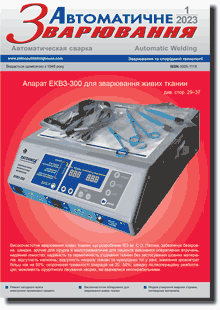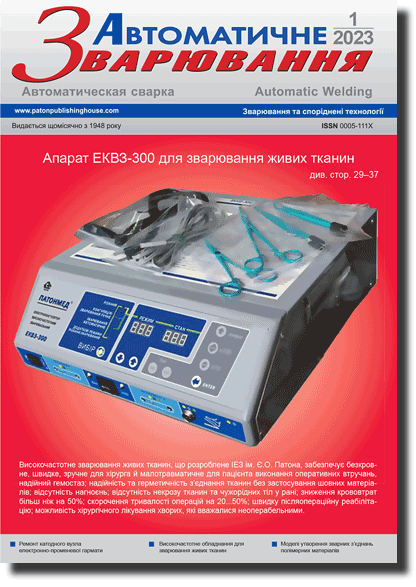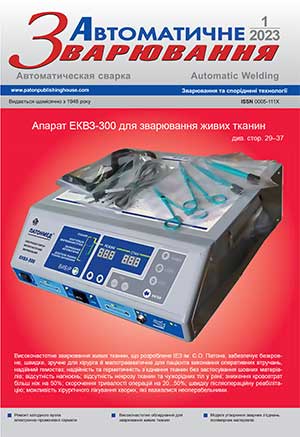| 2023 №01 (02) |
DOI of Article 10.37434/as2023.01.03 |
2023 №01 (04) |

"Avtomatychne Zvaryuvannya" (Automatic Welding), #1, 2023, pp. 16-21
Use of welding additive technologies in manufacture of metal parts of a complex shape (Review)
A.S. Novodranov, D.D. Topchev, A.M. Mangold, E.V. Shapovalov, V.O. Kolyada
E.O. Paton Electric Welding Institute of the NAS of Ukraine. 11 Kazymyr Malevych Str., 03150, Kyiv, Ukraine. E-mail: office@paton.kiev.uaAdditive technologies are the generalized name of technologies that associate the manufacture of parts according to the data of a digital model by the method of layer-by-layer adding of material. For the modern industry, additive manufacturing of metal parts of a complex shape is becoming increasingly relevant. The analysis of electric arc, laser and electron beam methods for realization of welding additive technologies as well as evaluation of the prospects and rationality of their use as compared to the alternative mechanical method of manufacturing of metal products was carried out. The advantages and disadvantages of each method as well as areas and features of application were determined. Examples of introduction of these methods in manufacture as well as their use in the composition of complex welding systems are presented. Despite a relatively low energy efficiency of laser additive technologies, they are featured by the highest accuracy of parts manufacturing. Electric arc methods for realization of additive technologies, on the contrary, have the highest energy efficiency, but manufactured parts require additional machining due to a relatively low manufacturing accuracy. A significant prospect in using the plasma-arc method of surfacing for manufacture of metal parts was noted due to a low heat capacity, high efficiency and a large range of consumables. The problems and features of surfacing of multilayered parts were considered. The prospects of using robotic complexes for solving the problems of automation of the processes of additive manufacturing of parts using WAAM technology were determined. The robotic complex on the basis of welding anthropomorphic robot in combination with external axes provides a significant increase in efficiency and flexibility of additive manufacturing, and additional equipment of the complex with the system of technical vision allows increasing the accuracy of WAAM of parts manufacturing. 29 Ref., 8 Fig.
Keywords: welding technologies, additive technologies, metal products, three-dimensional printing, electric arc surfacing, robotic equipment
Received: 24.10.2022
References
1. DebRoy, T., Wei, H.L., Zuback, J.S. et al. (2018) Additive manufacturing of metallic components - Process, structure and properties. Progress in Materials Science, 92, 112-224. https://doi.org/10.1016/j.pmatsci.2017.10.0012. Dickens, P.M. (1992) Rapid prototyping using 3-D welding. P r o - ceedings of the Solid Freeform Fabrication Symposium, 280-290.
3. Ding, D., Pan, Z., Cuiuri, D., Li, H. (2015) Wire-feed additive manufacturing of metal components: technologies, developments and future interests. International Journal of Advanced Manufacturing Technology, 81(1-4), 465-481. https://doi.org/10.1007/s00170-015-7077-3
4. Peleshenko, S.I., Korzhik, V.N., Voitenko, A.N. et al. (2017) Analysis of modern state of additive welding technologies for producing bulk metallic products. Eastern-European J. of Enterprise Technologies, 3/1(87), 42-52. https://doi.org/10.15587/1729-4061.2017.99666
5. Wong, K.V. (2012) A review of additive manufacturing. International Scholarly Research Network Mechanical Engineering, Article ID 208760. https://doi.org/10.5402/2012/208760
6. Zhukov, V.V., Grigorenko, G.M., Shapovalov, V.A. (2016) Additive manufacturing of metal products (Review). The Paton Welding J., 5-6(753),137-142. https://doi.org/10.15407/tpwj2016.06.24
7. Michaels, S., Sachs, E.M., Cima, M.J. (1992) Metal parts generation by three dimensional printing. Proceedings of the Solid Freeform Fabrication Symposium, 244-250.
8. Frazier, W.E. (2014) Metal additive manufacturing: a review. Journal of Materials Engineering and Performance, 23(6), 1917-1928. https://doi.org/10.1007/s11665-014-0958-z
9. RUDOLF SIEVERS [Електронний ресурс]. Gro bauteile aus Metall. https://www.rudolf-sievers.de/fileadmin-pft21/ RS/3D-Druck/PDF/RUDOLF%20SIEVERS%20-%20 3D-Druck%20Flyer%203DMP.pdf
10. Kazanas, P., Deherkar, P., Almeida, P. et al. (2012) Fabrication of geometrical features using wire and arc additive manufacture. Proceedings of the Institution of Mechanical Engineers, Part B: Journal of Engineering Manufacture, 226(6), 1042-1051. https://doi.org/10.1177/0954405412437126
11. Karakozov, E.S., Mustafaev, R.I. (1992) Evaluation of e ciency of welding processes: Refer. book of young welder, 46-47 [in Russian].
12. Kruth, J.P. (2004) Selective laser melting of iron-based powder. J. Mater. Process. Technol., 149, 616-622. https://doi.org/10.1016/j.jmatprotec.2003.11.051
13. Kruth, J.P. (1998) Progress in additive manufacturing and rapid prototyping. CIRP Annals-Manufacturing Technology, 47(2 ), 525-540. https://doi.org/10.1016/S0007-8506(07)63240-5
14. Wang, F., Williams, S., Colegrove, P., Antonysamy, A.A. (2012) Microstructure and Mechanical Properties of Wire and Arc Additive Manufactured. Metallurgical and Materials Transactions, 44, 968-977. https://doi.org/10.1007/s11661-012-1444-6
15. Li Johnnie Liew Zhonga, Alkahari Mohd Rizala, Rosli Nor Ana Bintia et al. (2019) Review of wire arc additive manufacturing for 3d metal printing. International Journal of Automation Technology, 13(3), 346-353. https://doi.org/10.20965/ijat.2019.p0346
16. Karunakaran, K.P., Suryakumar, S., Pushpa, V., Akula, S. (2010) Low cost integration of additive and subtractive processes for hybrid layered manufacturing. Robotics and Computer- Integrated Manufacturing, 26(5 ), 490-499. https://doi.org/10.1016/j.rcim.2010.03.008
17. (2018) Dezeen [Електронний ресурс]. Robots complete span of 3D-printed bridge for Amsterdam canal. https:// www.dezeen.com/2018/04/17/mx3d-3d-printed-bridgejoris- laarman-arup-amsterdam-netherlands/
18. Korzhik, V.N.,Khaskin, V.Yu., Grinyuk, A.A. et al. (2016) 3D-printing of metallic volumetric parts of complex shape based on welding plasma-arc technologies (Review). The Paton Welding J., 5-6(753), 117-123. https://doi.org/10.15407/tpwj2016.06.20
19. Williams, S.W., Martina, F., Addison, A.C., Ding, J. (2016) Wire+Arc Additive Manufacturing. Materials Science and Technology, 7, 641-647. https://doi.org/10.1179/1743284715Y.0000000073
20. SLM Solution [Електронний ресурс]. Meet the NXG XII 600 a new era in manufacturing. https://www.slm-pushingthe- limits.com/specs#the-nxg
21. (2021) Money Today [Електронний ресурс]. 3D printers also make propellant tanks for space launch vehicles. One step closer to self-su ciency in space parts. https://news.mt. co.kr/mtview.php?no=2021062414002837802
22. WALDUN [Електронний ресурс]. PTA Welding Machine Plasma Transferred Arc Welding (Plasma Transferred Arc) & System. https://www.hardfacingfty.com/pta-welding-equipment/
23. Geofabrica [Електронний ресурс]. Wire-arc additive manufacturing for metal part fabrication. https://geofabrica. com/directed-energy-deposition-waam/
24. Korzhik, V.N., Vojtenko, A.N., Peleshenko, S.I. et al. (2017) Development of automated equipment for manufacturing 3D metal products based on additive technologies. The Paton Welding J., 5-6, 79-85. https://doi.org/10.15407/tpwj2017.06.15
25. Pan Zengxi, Ding Donghong, Wu Bintao et al. (2018) Arc Welding Processes for Additive Manufacturing: A Review. Transactions on Intelligent Welding Manufacturing, 3-24. https://doi.org/10.1007/978-981-10-5355-9_1
26. Guessasma, S., Zhang, W., Zhu, J. et al. (2016) Challenges of additive manufacturing technologies from an optimization perspective. International Journal for Simulation and Multidisciplinary Design Optimization, 6, 9-13. https://doi.org/10.1051/smdo/2016001
27. Savyasachi, N, Sijo, Richard, Joel T James et al. (2020) A Review on Wire and Arc Additive Manufacturing (WAAM). International Research Journal of Engineering and Technology (IRJET), 7, 4981-4989.
28. Kiselevsky, F.N., Shapovalov, E.V., Kolyada, V.A. (2006) System of laser following of weld reinforcement. The Paton Welding J., 1, 60-62.
29. Lobanov, L.M., Shapovalov, E.V., Kolyada, V.A. (2014) Application of modern information technologies to solve problems of technological process automation. Tekh. Diagnost. i Nerazrush. Kontrol, 3, 20-28 [in Russian].
Advertising in this issue:
The cost of subscription/purchase order journals or individual articles
| Journal/Currency | Annual Set | 1 issue printed |
1 issue |
one article |
| TPWJ/USD | 384 $ | 32 $ | 26 $ | 13 $ |
| TPWJ/EUR | 348 € | 29 € | 24 € | 12 € |
| TPWJ/UAH | 7200 UAH | 600 UAH | 600 UAH | 280 UAH |
| AS/UAH | 1800 UAH | 300 UAH | 300 UAH | 150 UAH |
| AS/USD | 192 $ | 32 $ | 26 $ | 13 $ |
| AS/EUR | 180 € | 30 € | 25 € | 12 € |
| SEM/UAH | 1200 UAH | 300 UAH | 300 UAH | 150 UAH |
| SEM/USD | 128 $ | 32 $ | 26 $ | 13 $ |
| SEM/EUR | 120 € | 30 € | 25 € | 12 € |
| TDNK/UAH | 1200 UAH | 300 UAH | 300 UAH | 150 UAH |
| TDNK/USD | 128 $ | 32 $ | 26 $ | 13 $ |
| TDNK/EUR | 120 € | 30 € | 25 € | 15 € |
AS = «Automatic Welding» - 6 issues per year;
TPWJ = «PATON WELDING JOURNAL» - 12 issues per year;
SEM = «Electrometallurgy Today» - 4 issues per year;
TDNK = «Technical Diagnostics and Non-Destructive Testing» - 4 issues per year.









